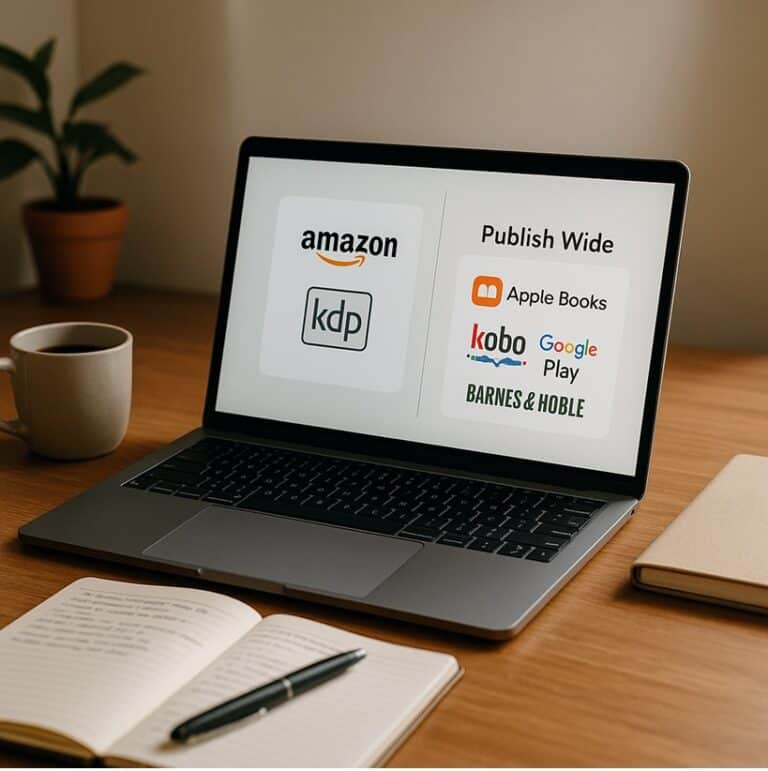Craft a Hardback Book: 4 Best Hacks

“Self-publishing is a great way to tell the world your story and make a living from your writing.” – Joanna Penn, The Creative Penn
As an independent author navigating the exciting world of publishing, you find yourself amidst both immense opportunities and formidable challenges. Embrace this opportunity to turn your manuscript into various formats, reaching a wider audience.
In today’s self-publishing era, offering your work in diverse formats (eBooks, audiobooks, hardback books, and even international translations) opens doors to a global readership, connecting you with more readers across the globe.
Hardback books hold a special allure, offering readers a sensory and prestigious experience that another publishing format doesn’t. The physical presence of a hardback (also called a hardcover) adds a sense of tradition and aesthetic value, often becoming a treasured item for many. By self-publishing in hardback, you enhance the book’s perceived value and longevity.
Expanding into various publishing formats is a testament to your commitment to meeting readers in their preferred medium. This approach acknowledges today’s diverse reading preferences and paves the way for discovering new markets and opportunities.
Such a strategic move can significantly increase your presence in self-publishing, where visibility and accessibility are key to success.
As an indie author, embracing this variety of formats signifies your leap into a broader, more inclusive, and exciting literary universe.
Ready to take the plunge?
Choosing to publish a hardback book makes a bold statement on bringing your writing to life. It’s about giving your work a durable form, but it exudes a sense of prestige and timelessness. As you embark on this path, it’s crucial to understand the nuances of hardback creation, from specifications to the use of AI.
The world of hardback books addresses everything from templates to best practices, creating a hardback to reflect your work’s value.
Understanding Technical Specifications
The first step in your hardback book journey is grasping the technical features. Unlike their digital counterparts, hardcovers have physical attributes that need careful consideration.
- Dimensions. The hardback book size influences the aesthetic. It also affects printing costs and shelf presence. Standard sizes like 6” x 9” or 5.5” x 8.5” are popular choices, but don’t be afraid to consider what best suits your manuscript.
- Paper. The choice of paper plays a significant role, too. Heavier paper weight lends a premium quality but adds to the shipping weight. Balance is key. Additionally, consider the type of binding. Typically, a hardback book uses case binding, where the book’s pages are sewn and then attached to a hardcover. This ensures durability and allows it to lie flat when opened, enhancing the reading experience.
Choosing the Right Hardback Book Templates
Templates are your roadmap in the process. They provide a structured layout for your book’s interior, ensuring that words and images are well-aligned and aesthetically pleasing. When selecting templates, consider your genre and audience. A visually driven book, such as a cookbook or a photography collection, might need an image-centric layout. Whereas a novel or memoir might require a text-focused one.
Many self-publishing platforms offer a range of templates designed for hardcovers. These templates consider margins, gutters, and bleed. They’re essential to ensure the manuscript is correctly printed without unintended cutoffs.
Incorporating AI & Other Considerations
Artificial Intelligence (AI) is a powerful ally in your hardback book creation process. AI-driven tools assist in layout, suggesting the best placement of text and images based on the content. They also help with editing, providing grammar, style, and structure suggestions.
For a historical fiction book, The Queen’s Cipher, an author might use AI to analyze popular cover designs in the genre, leading to a cover featuring a bold, golden cipher symbol against a dark, textured background. This design could appeal to fans of historical mysteries, suggesting intrigue and depth.
Beyond AI, other considerations like color schemes, typography, and cover design play a pivotal role.
The cover of your hardback book is its first impression. It should be captivating, reflective of the content, and professional. It’s worth considering hiring a designer, as the cover influences a reader’s decision to pick up your book.
Best Tools & Practices
Finally, consider the tools and practices to help you craft your hardback book. Several desktop publishing tools, like Adobe InDesign, are available, which many professionals use for their advanced features and flexibility. For those looking for simpler options, tools like Scribus or Microsoft Publisher offer user-friendly interfaces suitable for basic layouts.
When it comes to best practices, thorough proofreading and editing are non-negotiable. A hardback is often seen as a collector’s item, so errors and typos detract from its value. Consider doing a test print. This allows you to check the physical aspects (the paper, the quality of the print, the binding), ensuring everything meets your expectations.
Another best practice is to seek feedback. Share your test prints with a small group of readers or other authors. Their insights are often invaluable when making final adjustments before bulk printing.
TIP: Order sample copies from different print-on-demand providers to assess quality before making your final choice.
Creating a hardback book requires careful planning, attention to detail, and a touch of creativity. It’s about giving your story a form that resonates with quality and durability. By understanding the technicalities, leveraging the proper templates and AI tools, and following best practices, you’re well on your way to creating a hardback that tells a story or solves a problem and stands the test of time.
Embrace this process, for at the end of it lies a tangible manifestation of your creative vision, ready to grace the shelves of readers who appreciate the art of a well-crafted book.
Embrace the Hardback Book Option
The world of indie publishing is brimming with potential. Each format, from e-books to audiobooks and hardcovers, offers unique considerations and opportunities. Each option creates a stepping stone toward your success.
In the world of hardback publishing, the physical attributes of your book—its size, paper quality, and binding—are crucial. They shape the reader’s physical interaction with your work. It’s about choosing the right template and using AI tools for design and editing, aiming to produce a hardback book that’s a testament to your commitment. The technological tools and design elements are your allies in molding your story.
Through the varied formats, one element remains unwavering: your distinct voice and narrative. Whether it’s an eBook, audiobook, hardcover, or translation, the core of your work should consistently shine through. Your passion for storytelling, writing, or problem-solving is the heart of your journey. The tools and knowledge available are here to support you in sharing your story with the world.
Branching out into different formats broadens your reach and helps form a deeper connection with your audience. Each new format you explore and market you penetrate enriches your journey, drawing you closer to your readership. Embrace this learning process and experiment with various methodologies.
This journey in self-publishing is uniquely yours. The paths of different formats are gateways to unique experiences and opportunities. Use available resources, trust in your creative instincts, and, most importantly, relish the process of turning your vision into a reality.
As the publishing landscape evolves, so should your approach as an indie author. Creating different formats is a strategic move towards increased accessibility, reaching broader audiences, and achieving success. Seize this chance to reach more readers. We encourage you to continue your journey by reading other writer’s guides in this series. Each writer’s guide is designed to build your understanding and skills, ultimately leading you toward successfully self-publishing a book that resonates with readers. Embrace the journey enthusiastically and let these resources guide you toward realizing your dreams.
This series is based on insights from our book, Is Your Book Ready to Self-Publish? It covers crucial aspects of self-publishing and provides practical advice to aspiring indie authors.
We hope you’ve found the hardback strategies inspiring and motivating. We’re here to help you with the insights and tools needed to succeed as a new indie author.
Writing requires ongoing learning and growth. But it doesn’t have to be a solo path. We’re delighted to journey with you, providing support and encouragement along the way. We seek to provide understanding and practical advice to help you navigate the self-publishing world with increasing confidence.
For more assistance, see our other guides in this series on preparing your manuscript for self-publishing. We suggest starting with the first guide in the series. For more details on all of these sections and more, read Is Your Book Ready to Self-Publish. Lastly, for help writing a non-fiction book, read Write Your First Non-Fiction eBook: a 30-Day Workbook for Getting It Done.
Don’t wait. Start today!
How can we help? To let us know, please fill out our contact form. Happy writing!
FAQs
What are the cost implications of choosing hardback over other formats?
Answer: Hardback books generally cost more to produce than paperback or digital formats due to the materials and binding process involved. This could mean a higher retail price, but it also offers a perception of higher quality and durability.
How does hardback publishing affect distribution options?
Answer: While hardbacks are often favored in traditional retail settings for their shelf presence, they can pose challenges in shipping and handling due to their weight and size. Indie authors should consider these factors when planning distribution.
Can I convert my existing eBook or paperback into a hardback format?
Answer: Yes, it’s possible to convert your existing eBook or paperback into a hardback format. You’ll need to adjust the layout and cover design to meet hardback specifications, and you may need to find a printer specializing in hardback binding.
Are there specific design considerations for hardback covers?
Answer: Hardback covers often require additional design elements, such as spine artwork and flap copy. The quality of materials used for the cover, like cloth or leather, can also impact the overall aesthetic and durability of the book.
How does print-on-demand work for hardback books?
Answer: Print-on-demand for hardback books is increasingly available, but it can be more expensive per unit than bulk printing. This option allows authors to print books as they are ordered, reducing upfront costs and the risk of unsold inventory.

